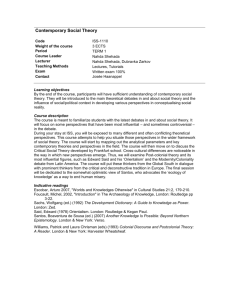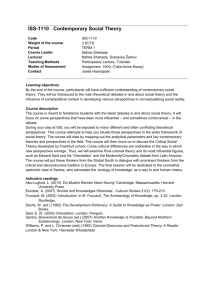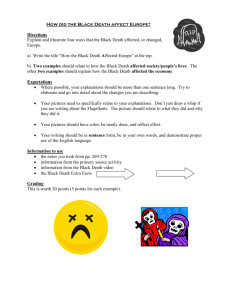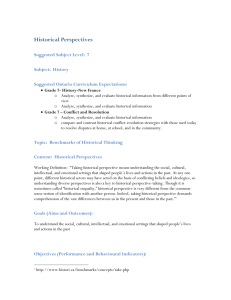1 An Overview of Organizational Behavior
advertisement
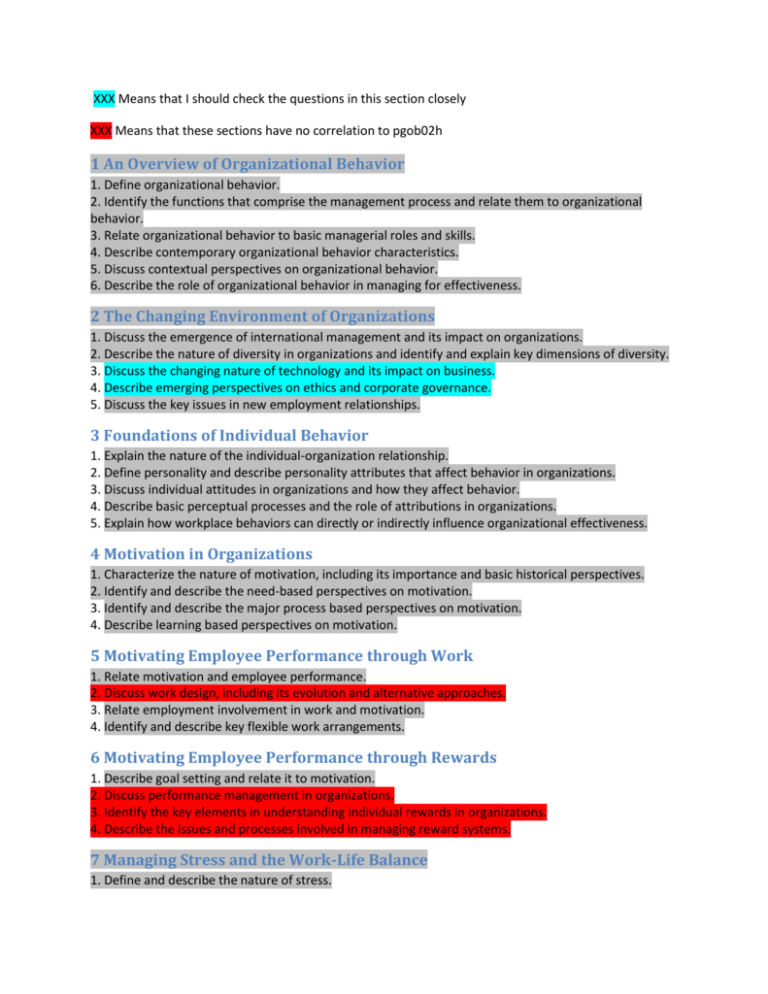
XXX Means that I should check the questions in this section closely XXX Means that these sections have no correlation to pgob02h 1 An Overview of Organizational Behavior 1. Define organizational behavior. 2. Identify the functions that comprise the management process and relate them to organizational behavior. 3. Relate organizational behavior to basic managerial roles and skills. 4. Describe contemporary organizational behavior characteristics. 5. Discuss contextual perspectives on organizational behavior. 6. Describe the role of organizational behavior in managing for effectiveness. 2 The Changing Environment of Organizations 1. Discuss the emergence of international management and its impact on organizations. 2. Describe the nature of diversity in organizations and identify and explain key dimensions of diversity. 3. Discuss the changing nature of technology and its impact on business. 4. Describe emerging perspectives on ethics and corporate governance. 5. Discuss the key issues in new employment relationships. 3 Foundations of Individual Behavior 1. Explain the nature of the individual-organization relationship. 2. Define personality and describe personality attributes that affect behavior in organizations. 3. Discuss individual attitudes in organizations and how they affect behavior. 4. Describe basic perceptual processes and the role of attributions in organizations. 5. Explain how workplace behaviors can directly or indirectly influence organizational effectiveness. 4 Motivation in Organizations 1. Characterize the nature of motivation, including its importance and basic historical perspectives. 2. Identify and describe the need-based perspectives on motivation. 3. Identify and describe the major process based perspectives on motivation. 4. Describe learning based perspectives on motivation. 5 Motivating Employee Performance through Work 1. Relate motivation and employee performance. 2. Discuss work design, including its evolution and alternative approaches. 3. Relate employment involvement in work and motivation. 4. Identify and describe key flexible work arrangements. 6 Motivating Employee Performance through Rewards 1. Describe goal setting and relate it to motivation. 2. Discuss performance management in organizations. 3. Identify the key elements in understanding individual rewards in organizations. 4. Describe the issues and processes involved in managing reward systems. 7 Managing Stress and the Work-Life Balance 1. Define and describe the nature of stress. 2. Identify basic individual differences related to stress. 3. Identify and describe common causes of stress. 4. Discuss the central consequences of stress. 5. Describe various ways that stress can be managed. 6. Discuss work-life linkages and their relation to stress. 8 Decision Making and Problem Solving 1. Describe the nature of decision making and distinguish it from problem solving. 2. Discuss the rational approach to decision making. 3. Identify and discuss the primary behavioral aspects of decision making. 4. Discuss the nature of creativity and relate it to decision making and problem solving. 9 Foundations of Interpersonal and Group Behavior 1. Discuss the interpersonal nature of organizations. 2. Define a group and illustrate their importance in organizations. 3. Identify and discuss the types of groups commonly found in organizations. 4. Describe the general stages of group development. 5. Discuss the major group performance factors. 6. Discuss intergroup dynamics. 7. Describe group decision making in organizations. 8. Foundations of Interpersonal and Group Behavior. 10 Using Teams in Organizations 1. Differentiate teams from groups. 2. Identify and discuss the benefits and costs of teams in organizations. 3. Identify and describe various types of teams. 4. Describe how organizations implement the use of teams. 5. Identify essential conditions for promoting team success. 11 Communication in Organizations 1. Discuss the nature of communication in organizations. 2. Identify and describe the primary methods of communication. 3. Describe the communication process. 4. Note how information technology affects communication. 5. Identify and discuss the basic kinds of communication networks. 6. Discuss how communication can be managed in organizations. 12 Traditional Models for Understanding Leadership 1. Characterize the nature of leadership. 2. Trace the early approaches to leadership. 3. Discuss the emergence of situational theories and models of leadership. 4. Describe the LPC theory of leadership. 5. Discuss the path-goal theory of leadership. 6. Describe Vroom’s decision tree approach to leadership. 13 Contemporary Views of Leadership in Organizations 1. Identify and describe contemporary situational theories of leadership. 2. Discuss leadership through the eyes of followers. 3. Identify and describe alternatives to leadership. 4. Describe the changing nature of leadership. 5. Identify and discuss emerging issues in leadership. 14 Power, Politics, and Organizational Justice 1. Define and discuss influence in organizations. 2. Describe the types and uses of power in organizations. 3. Discuss politics and political behavior in organizations. 4. Describe the various forms and implications of justice in organizations. 15 Conflict and Negotiation in Organizations 1. Define and discuss the nature of conflict in organizations. 2. Identify and describe the common forms and causes of conflict. 3. Discuss the most frequent reactions to conflict in organizations. 4. Describe how conflict can be managed. 5. Define negotiation in organizations and discuss its underlying processes. 16 Foundations of Organization Structure 1. Define organization structure and discuss its purpose. 2. Describe the classic views of organization structure. 3. Describe structural configuration and summarize its four basic dimensions. 4. Discuss two structural policies that affect operations. 5. Explain the dual concepts of authority and responsibility. 17 Organization Design 1. Describe the basic premise of contingency approaches to organization design. 2. Discuss how strategy and the structural imperatives combine to affect organization design. 3. Summarize five types of organization designs. 4. Explain several contemporary approaches to organization design. 18 Organization Culture 1. Define organization culture, explain how it affects employee behavior, and understand its historical roots. 2. Describe how to create organization culture. 3. Describe two different approaches to culture in organizations. 4. Identify emerging issues in organization culture. 5. Discuss the important elements of managing the organizational culture. 19 Organization Change and Development 1. Summarize the dominant forces for change in organizations. 2. Describe the process of planned organization change. 3. Discuss several approaches to organization development. 4. Explain resistance to change. 5. Identify the keys to managing successful organization change and development.
